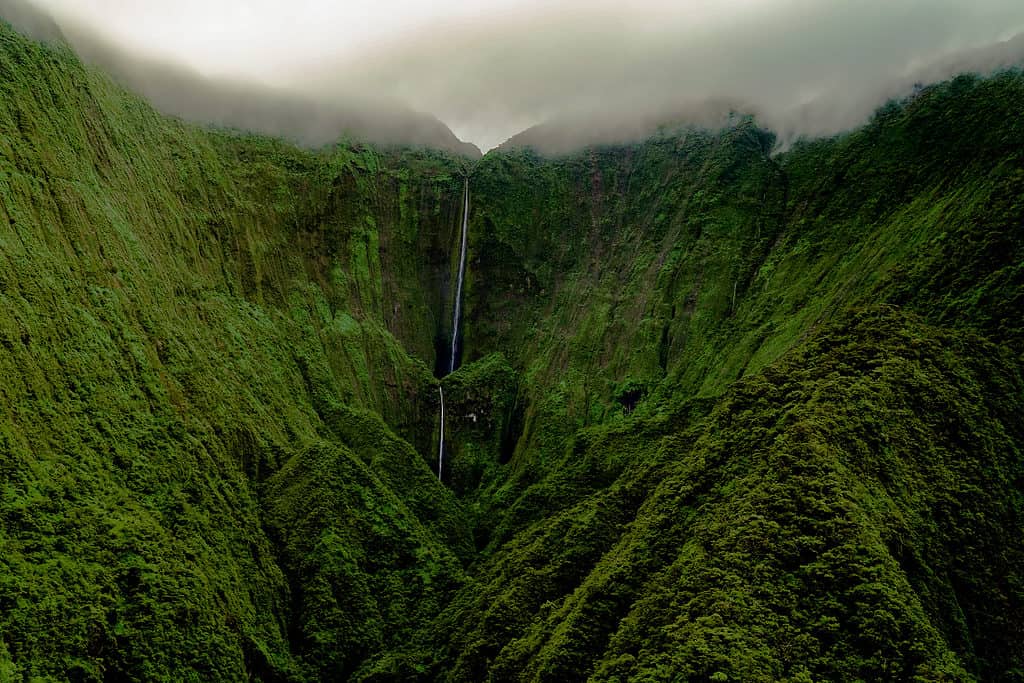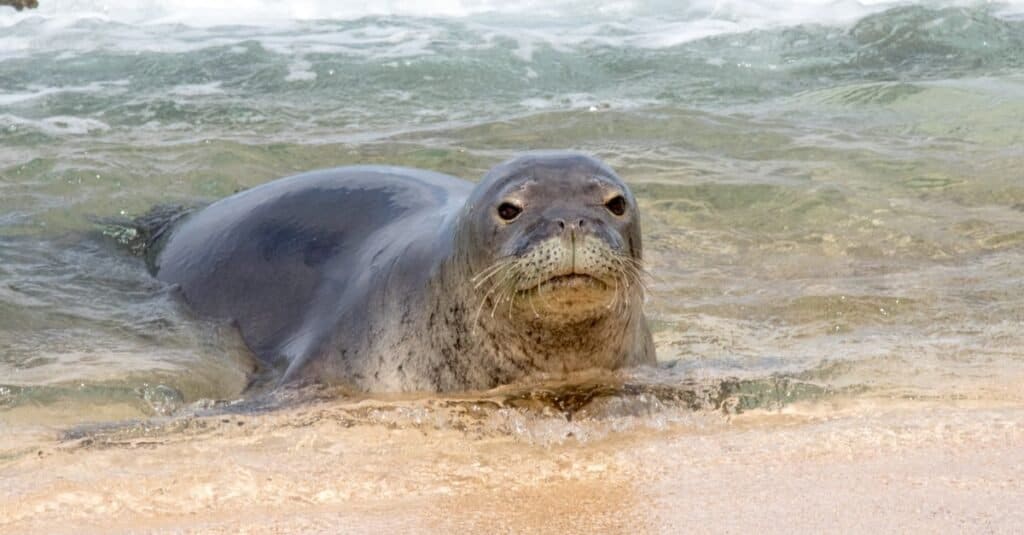Key Points
- Olo’upena Falls is the tallest waterfall in Hawaii, at 2,953 feet.
- It is also the tallest waterfall in the United States.
- Hawaii is home to the three tallest waterfalls in the USA.
Hawaii is an incredibly diverse and beautiful island chain located in the Pacific Ocean. The eight major islands are Kauaʻi, Oʻahu, Maui, Hawaiʻi Island (also known as the “Big Island”), Molokaʻi, Lānaʻi, Kaho’olawe, and Ni’ihau. Each of these islands offers its own unique characteristics. In Hawaii, you can see everything from lush rainforests to secluded beaches to breathtaking volcanoes and waterfalls.
The three tallest waterfalls in the USA are all found in the Hawaiian Islands. Let’s check them out!
Climate
The climate of Hawaii is tropical and subtropical, with warm temperatures year-round. The average summer temperature is 88°F, and the winter average is 83°F. Temperatures rarely drop under 60 degrees Fahrenheit, even at low elevations. The islands are located in the central Pacific Ocean and have a humid, hot atmosphere. Rainfall occurs throughout the year, although it tends to be heavier from November through March, due to seasonal rainstorms known as “Kona storms.” In addition, the Hawaiian Islands experience occasional high winds and tropical storms during hurricane season between August and October, which can cause rough surf conditions on many beaches.
What is a Waterfall?
Waterfalls are sudden and steep drops in a river or other body of water, with water flow plunging into a pool below. Erosion, which is the incremental wearing away of the earth, is a major factor in the formation of waterfalls, and waterfalls themselves also contribute to this process.
Generally, waterfalls materialize when streams transition from solid rock to a softer type of rock. This erosion transpires both horizontally (as a stream moves along the ground) and vertically (as the stream cascades over in a waterfall). In either situation, the less firm rock disintegrates, leaving a tough edge that the stream pours over.
There is some disagreement about what should be classified as a waterfall. Most people accept the following definition: Any creek, river, or stream that drops from a height of at least 10 feet and has a gradient of 30 degrees or more.
How do Waterfalls Form?
Waterfalls can originate from rivers, creeks, glaciers, and streams. Two of the biggest waterfalls in the world are sourced from glaciers, while the majority come from rivers.
According to geology, the erosive properties of rivers, which move over different layers of rocks with varying levels of erosion, create waterfalls. As the watercourse progresses, the softer rocks wear away more quickly than the harder rocks, leading to the formation of a waterfall.
As time passes, the erosion of the softer rock layer leads to a steeper water route. The river starts to weaken the hard rock layer until it creates an overhang. Eventually, the overhanging hard rock becomes unsteady due to the erosive process, which can cause it to collapse and tumble.
As the water’s speed accelerates, it begins to fall at a steeper angle. Eventually, it reaches a point where it is almost or entirely vertical, resulting in the creation of a waterfall that plunges over the edge into a pool.
The Tallest Waterfall in Hawaii – Olo’upena Falls

©Brandon Means/Shutterstock.com
Olo’upena Falls, situated in Maui County, is the tallest waterfall in Hawaii. It is also the highest waterfall in the entire United States! Measuring a vertical drop of 2953 feet, it cascades down the steep slopes on the northern side of Molokai Island.
Olo’upena Falls is an awe-inspiring spectacle. Located on one of the tallest sea-facing cliffs in the world, between the Pelekunu and Wailau valleys, it can be observed only from a boat or airplane. The falls occur when a short seasonal stream cascades over the edge of this mighty cliff into a deep crevice below. Over time, Olo’upena Falls has eroded a groove in its rocky face, creating an incredible display when viewed from the ocean. Though it is not accessible to visitors on foot due to its remote location, it remains one of Hawaii’s most impressive natural wonders.
Wildlife in the Area

©Lorraine Logan/Shutterstock.com
Hawaii is a vibrant and diverse ecosystem with many unique species of animals. Native mammals include the Hawaiian monk seal and Hawaiian hoary bat. While visiting the waterfall, you may be lucky enough to see a Laysan albatross or a Hawaiian goose (nēnē).
If you travel to the waterfall by boat, keep your eyes peeled for green sea turtles, monk seals, humpback whales, and spinner dolphins.
Second Highest Waterfall in Hawaii- Pu’uka’oku Falls
The northern side of Molokai is home to some of the highest waterfalls worldwide. Close to Olo’upena Falls is Pu’uka’oku Falls, which many believe is the second tallest waterfall in the US. This majestic waterfall has an estimated height of 2,756 feet.
This waterfall only receives enough water to flow during and after rainfall or from stream runoff. This area of Hawaii has an average rainfall of 80-140 inches per year, so it flows fairly often.
The source of these waterways is quite minimal, and the gap between the origin and the beginning of the falls is less than two miles. The waterfall almost immediately activates when there is a lot of rain in the area where the stream starts. As soon as the rain stops or slows, water streaming over the falls begins to lessen.
Reaching Olo’upena Falls and Pu’uka’oku Falls is a challenging feat. Because thick vegetation surrounds this isolated spot in Molokai, it is not accessible by land. The only way to get a good look at these breathtaking falls is to take a chartered helicopter or boat ride.
Third Tallest Waterfall in Hawaii – Waihilau Falls
Discover Waihilau Falls, the third-tallest waterfall in Hawaii, located in the Waimanu Valley on the main island of Hawaii. At a towering 2600 feet, it is a difficult destination to reach, as there is no paved road or maintained trail to help you get there.
Waihilau Falls is composed of three long and thin streams of white water cascading down a steep cliff surrounded by lush greenery. With easier access, this could be a popular destination.
It isn’t easy to reach the area, which is why it remains pristine. It’s not the kind of place a casual hiker will come across, but those with a deep love of nature will find their way. This region is a valley of an extinct volcano and is home to four tall waterfalls. The tallest of these is Waimanu Falls on the western side, with Wai’ilikahi, Kakaauki, and Lahomene all towering above 1,000 feet. Visitors that make it to this corner of Hawaii will be well rewarded.
Types of Waterfalls
Our planet is incredibly fascinating, with beauty in many forms, including distinct kinds of waterfalls! Every waterfall is unique and can look different from year to year or season to season. Here are descriptions of several types of waterfalls:
Plunge – Plunge waterfalls fall straight down vertically. The water does not touch the rock surface on the way down. A good example of a plunge waterfall is Blencoe Falls in Australia.
Horsetail – Horsetail waterfalls also fall vertically, but the water remains in contact with the rock face on the way down. Bridal Veil Falls in Canada is a waterfall of this type.
Cataract – Cataract waterfalls are very large and powerful, like Chitrakoot Falls in India.
Multi-step – Multi-step waterfalls are a series of falls that are close in size, and each has its own plunge pool, just like Ouzoud Falls in Morocco.
Block – Block waterfalls originate from rivers and streams that are very wide. One block waterfall is Rhine Falls in Switzerland.
Cascade – Cascade waterfalls flow over descending rock steps. Swallow Falls in the United Kingdom is a beautiful cascade waterfall.
Segmented – Segmented waterfalls split into two or more flows of water after they descend. A good example of a segmented waterfall is Depot Creed Falls in the United States.
Tiered – Tiered waterfalls drop downward onto steps that are separate from each other, like Helmet Falls in Canada.
Punchbowl – Punchbowl waterfalls are narrow at the top and then open up into a much wider area at the pool.
NEXT UP:
- How Many Volcanoes are in Hawaii?
- Discover the Deadliest Animals in Hawaii
- Discover the Coldest Place in Hawaii
The post Discover the Tallest Waterfall in Hawaii (2,953 Feet!) appeared first on AZ Animals.
from Animal News, Facts, Rankings, and More! - AZ Animals https://ift.tt/f7Z36w4